WANT TO SAVE THIS RECIPE?
The cornerstone of any recipe is its ingredients. For the Vegetable Beef Soup, you’d want to ensure that each ingredient is chosen carefully to provide that savory depth of flavor.
- Meat Choice: Stewing beef is your best option. It’s economical, and when cooked properly, provides that melt-in-your-mouth texture everyone loves. It’s essential to pick beef that’s marbled with fat for the best results. This ensures your soup has a rich and hearty flavor.
- Wine or Beer? As outlined in the recipe, red wine, Guinness beer, or stout can be used. Red wine brings a classic beef stew flavor. If you’ve ever tasted the Irish Guinness Stew, you’ll understand the depth Guinness adds. While alcohol does enhance the flavor, its absence won’t make the soup any less delightful.
- Veggies and Aromatics: Onions, garlic, celery, and carrots are the primary aromatics. They provide a base flavor that complements the beef. Don’t forget about the potatoes, which add body to the soup and the peas which bring in a pop of color and freshness.
- Herbs and Broth: Bay leaves and thyme are the primary herbs. The beef broth/stock should be low in sodium to manage the saltiness, and the touch of tomato paste adds richness.
- Buttery Mushrooms: Though optional, sautéing mushrooms in butter and adding them towards the end introduces a golden-brown texture and flavor. If you’re a fan of mushrooms in your Chicken Noodle Soup, this is a step you wouldn’t want to skip.
- Flour and Seasoning: Flour thickens the broth, turning it into a gravy-like consistency. Salt and pepper, though simple, season the soup and bring out the flavors of the other ingredients.
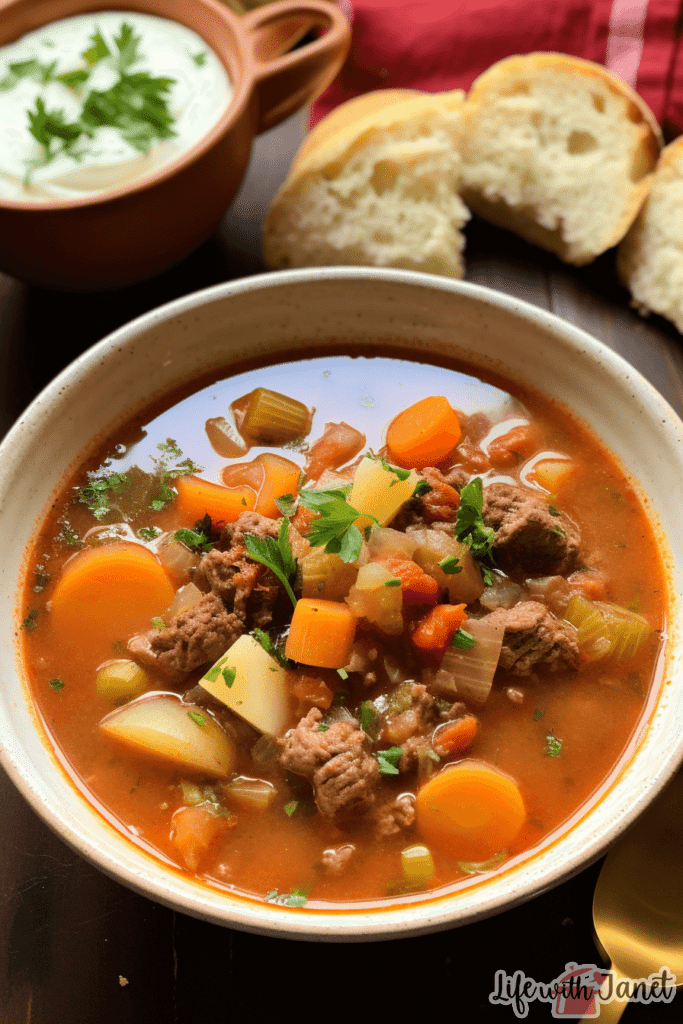
How do you achieve the perfect broth consistency?
The perfect broth consistency in Vegetable Beef Soup is achieved through several steps. One might think it’s as simple as mixing the ingredients together, but there’s more to the broth’s secret.
- Browning the Beef: This is a fundamental step. When beef is browned aggressively, it not only enhances the flavor of the beef itself but also enriches the broth from the brown bits that dissolve into it.
- Using Flour: Introducing flour and ensuring it’s stirred properly with the broth and beer/wine/stout mixture provides that slightly thickened texture that stands out in this recipe.
- Simmering: Letting the soup simmer on medium-low heat allows the ingredients to break down slowly, which naturally thickens the broth. It’s essential to ensure it’s bubbling gently and not boiling vigorously.
- The Secret Ingredient: Wine, beer, or stout. As mentioned, these not only add depth in flavor but also influence the consistency of the broth. The alcohol cooks out, so you’re only left with a delicious flavor.
- Addition of Starch: Potatoes are natural thickeners. When potatoes break down, they release starch which aids in giving the soup a heartier consistency.
- Final Adjustments: Before serving, it’s always good to check and adjust the seasoning. Sometimes, just a pinch of salt or pepper can make a difference in the taste and consistency of the broth. If you’ve ever tried the One-Pot Lasagna Soup Recipe, you’ll understand the importance of final adjustments.
Why is wine or beer recommended in the recipe?
Incorporating wine or beer into a Vegetable Beef Soup recipe isn’t just about adding alcoholic content; it’s about amplifying flavor. Here’s why:
- Complexity and Depth: Wine, especially red wine, can add a sophisticated note to dishes. Its acidity can help balance the richness of the beef, and its fruity undertones can highlight and complement the natural sweetness of the vegetables.
- Beer & Stout: These two bring in maltiness and a touch of bitterness that can create an interesting contrast with the other flavors in the soup. If you’re familiar with the taste of stouts, you’d recognize that they can add a roasted, almost coffee-like flavor, enhancing the soup’s overall profile.
- Deglazing the Pan: After browning the beef, there might be bits stuck to the pot’s bottom. Adding wine or beer helps in lifting these flavorful bits, incorporating them back into the broth.
- Alcohol Cooks Off: For those concerned about the actual alcohol, it’s worth noting that it gets cooked off during the simmering process. What’s left behind are the non-alcoholic flavors that improve the soup’s taste.
- Alternatives: If for any reason one chooses to opt out of using wine or beer, there are alternatives like crushed tomatoes and Worcestershire sauce that can also add unique flavors to the soup.
- A Note on Choice: Between wine, stout, and Guinness, it’s a matter of personal preference. Red wine for a classic taste, stout for a deep intense flavor reminiscent of Irish Guinness Stew, and Guinness for a balanced in-between.
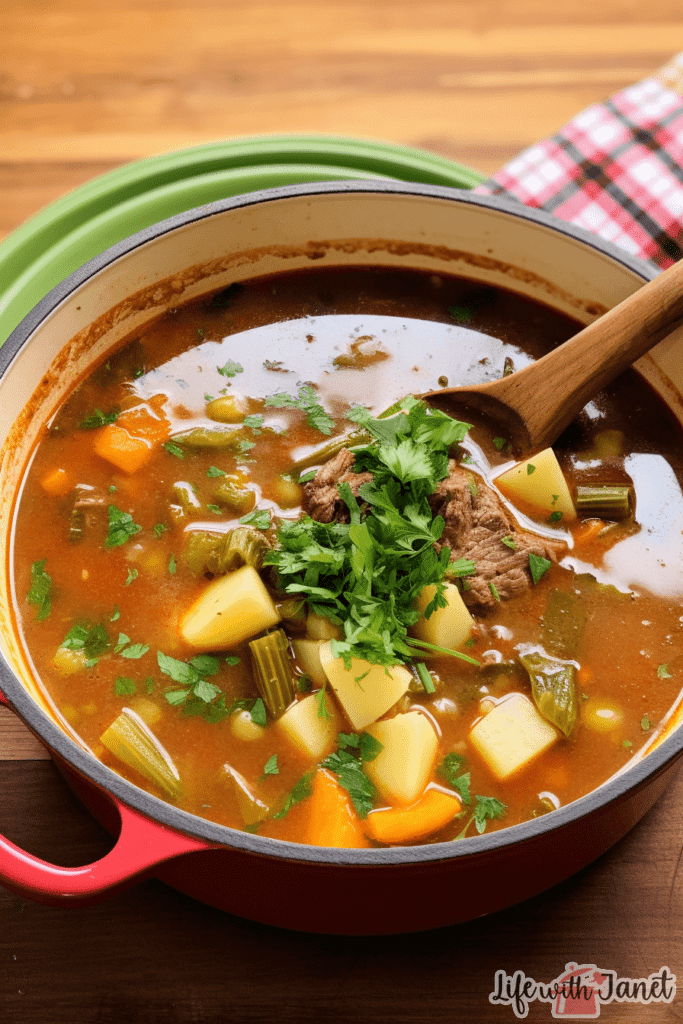
How do you ensure the beef is tender in the Vegetable Beef Soup?
Tenderness in beef is paramount, especially in a dish like Vegetable Beef Soup where the meat’s texture plays a crucial role.
- Choice of Beef: As previously mentioned, the ideal beef for this soup would be stewing or braising beef. Cuts like chuck or boneless short rib, which are marbled with fat, ensure that the beef remains juicy and tender.
- Browning is Crucial: This step isn’t just about color; it’s about flavor and texture. Browning the beef seals in its juices and ensures that it doesn’t turn rubbery during the simmering process.
- Slow Simmer: Cooking the beef gently over a longer duration allows its tough fibers to break down. The collagen in the beef melts into the broth, giving the soup its body and ensuring that the beef itself is fall-apart tender.
- Smaller Cut Size: Cutting the beef into smaller bite-sized cubes ensures it cooks uniformly. Larger pieces might not cook evenly, with the outer parts overcooking while the center remains tough.
- Avoid Boiling: Boiling can toughen the beef. It’s crucial to maintain a gentle simmer to ensure the beef remains tender throughout the cooking process.
- Testing for Tenderness: One can use a fork, but the recipe suggests using chopsticks, highlighting how effortlessly the beef should fall apart.
What vegetables can be added or substituted in the Vegetable Beef Soup?
While the recipe provides a list of vegetables, Vegetable Beef Soup can be versatile. Here are some suggestions:
- Mushrooms: They are optional in the original recipe, but mushrooms can be a delicious addition. They bring an earthy flavor and meaty texture which complements the beef.
- Green Beans: These can be a crunchy addition if you add them in the last 15 minutes of cooking.
- Corn: Fresh or frozen corn can introduce sweetness and an extra layer of texture.
- Substituting Potatoes: If you’re not a fan of potatoes or are looking for a low-carb alternative, you can use turnips or cauliflower florets.
- Zucchini and Bell Peppers: They add color and freshness. However, they should be added towards the end of the cooking process as they don’t require long simmering times.
- Spinach or Kale: These greens wilt quickly, so they should be stirred in just before serving. They provide a contrasting color and boost the soup’s nutritional value.
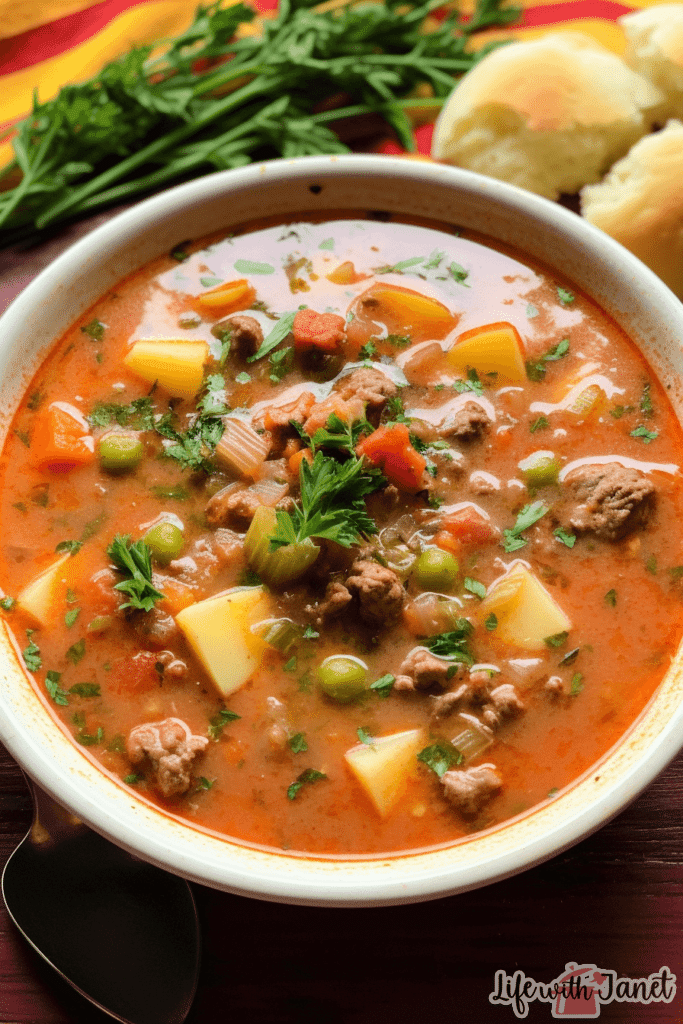
How to store and reheat the Vegetable Beef Soup?
Proper storage ensures the Vegetable Beef Soup remains flavorful and prevents it from spoiling.
- Cooling Before Storing: It’s essential to let the soup come to room temperature before refrigerating. Storing hot soup can lead to condensation, which affects the soup’s texture and can also cause bacterial growth.
- Storing in Airtight Containers: This prevents external flavors from contaminating the soup and also ensures it remains fresh. The soup can last for 3-4 days in the fridge.
- Freezing: If you’ve made a large batch, you can freeze the soup. Ensure you leave some space at the top of your container as the soup will expand when frozen. When properly stored, it can last for up to 3 months in the freezer.
- Reheating: It’s recommended to thaw the soup in the refrigerator overnight if frozen. Then, transfer it to a pot and reheat on medium-low, stirring occasionally. If you find the soup too thick upon reheating, you can add a bit of broth or water to adjust its consistency.
- Microwave Reheating: While stovetop is preferred, you can reheat in the microwave. Ensure you use a microwave-safe container, stir the soup midway through heating, and always check its temperature before consuming.
- Remember: It’s advised to reheat the soup only once. Repeated heating and cooling can affect the soup’s texture and might also lead to bacterial growth.
Another suggest recipe from Rachel cooks with love ❤
Vegetable Beef Soup Recipe
Ingredients
- 1.5 tbsp olive oil
- 500 g/1 lb stewing beef cubed (approx. 2/3″ size)
- Salt and pepper to taste
- 1 onion finely chopped
- 3 garlic cloves minced
- 2 celery stalks sliced (about 1/3″)
- 3 carrots sliced (around 1/5″), halve if large
- 4 tbsp flour
- 2.5 cups low sodium beef broth 625ml
- 1.5 cups dry red wine Guinness beer, or stout (375ml)
- 1.5 cups water 375ml
- 2 tbsp tomato paste
- 2 bay leaves
- 1 tsp dried thyme
- 1 cup frozen peas
- 2 potatoes cubed (approx. 2/3″)
- Optional: Buttery mushrooms See method below
Instructions
- Heat olive oil in a large pot over high heat. Dry the beef using paper towels, season with salt and pepper, then brown in batches. Set aside.
- If needed, add more oil to the pot. Sauté onion and garlic for 2 minutes.
- Introduce carrots and celery, and cook until onions turn translucent.
- Mix in flour gradually, then pour in beef broth while stirring continuously.
- Incorporate the beer/wine, water, tomato paste, bay leaves, and thyme. Return the beef to the pot.
- Cover and let it simmer on medium-low heat for around 1 hour 15 minutes, or until the beef softens.
- Add potatoes and peas, continuing to simmer for another 20 minutes without the lid. Introduce the cooked mushrooms in the last 5 minutes.
- Once the beef and potatoes are tender, adjust seasoning, garnish with parsley, and serve with crusty bread or garlic bread.
Buttery Mushrooms (Optional):
- In a skillet, melt butter over medium-high heat. Add mushrooms, cooking until browned. Season with salt and pepper.
Notes
- Beef: Opt for marbled stewing or braising beef. Cuts like chuck or boneless short rib work best.
- Flavor Enhancers: The red wine, Guinness, or stout provides a distinctive flavor. For a non-alcoholic variant, combine crushed tomatoes (400g/14 oz can) with 2 tsp Worcestershire sauce.
- Storage: Tastes even better the next day and can be stored in the fridge for up to 5 days. Also suitable for freezing.
Nutrition
WANT TO SAVE THIS RECIPE?




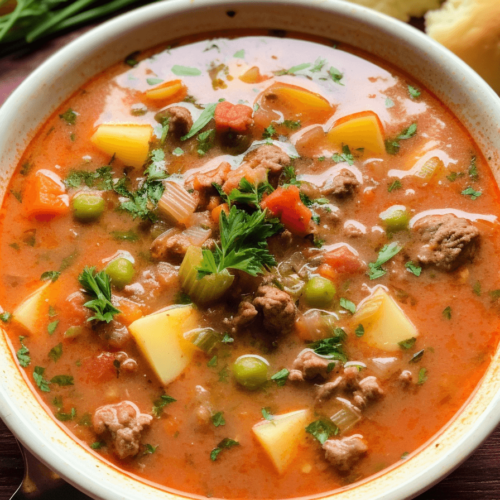
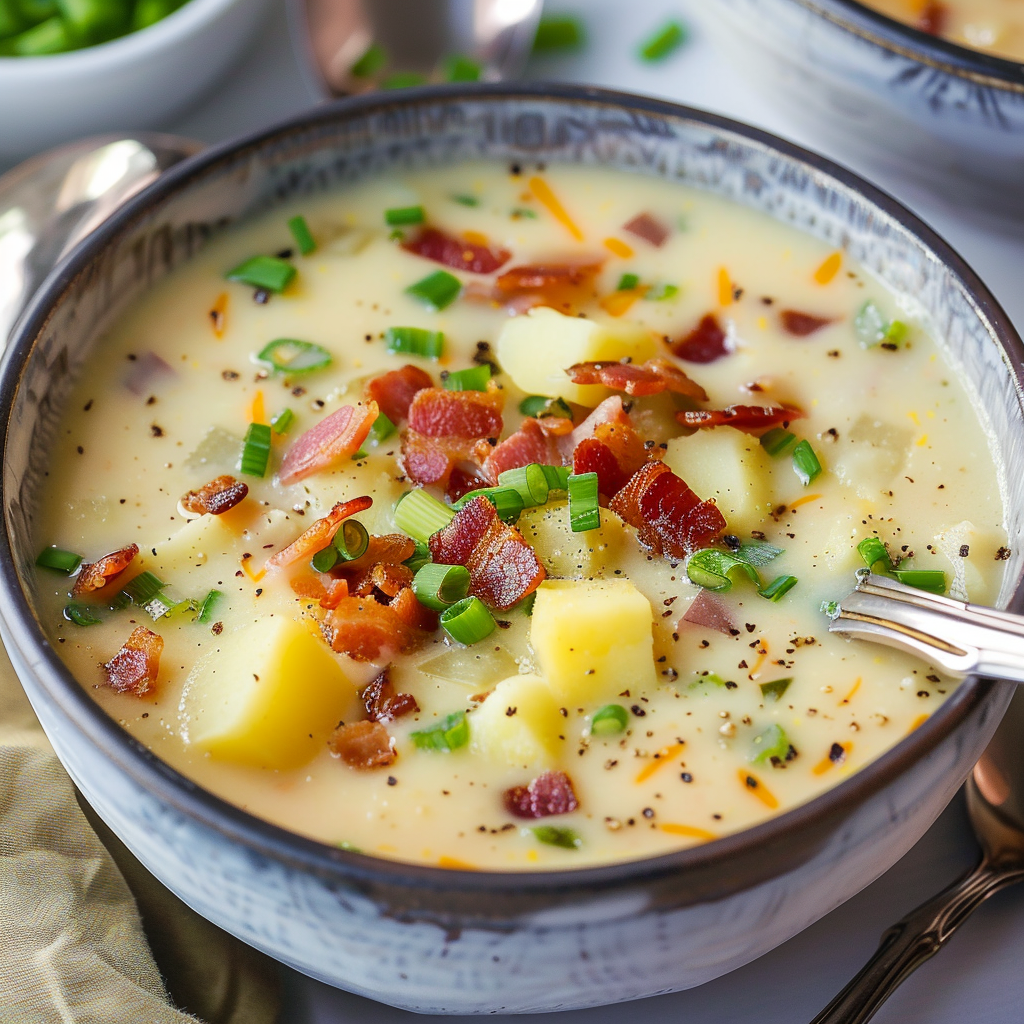

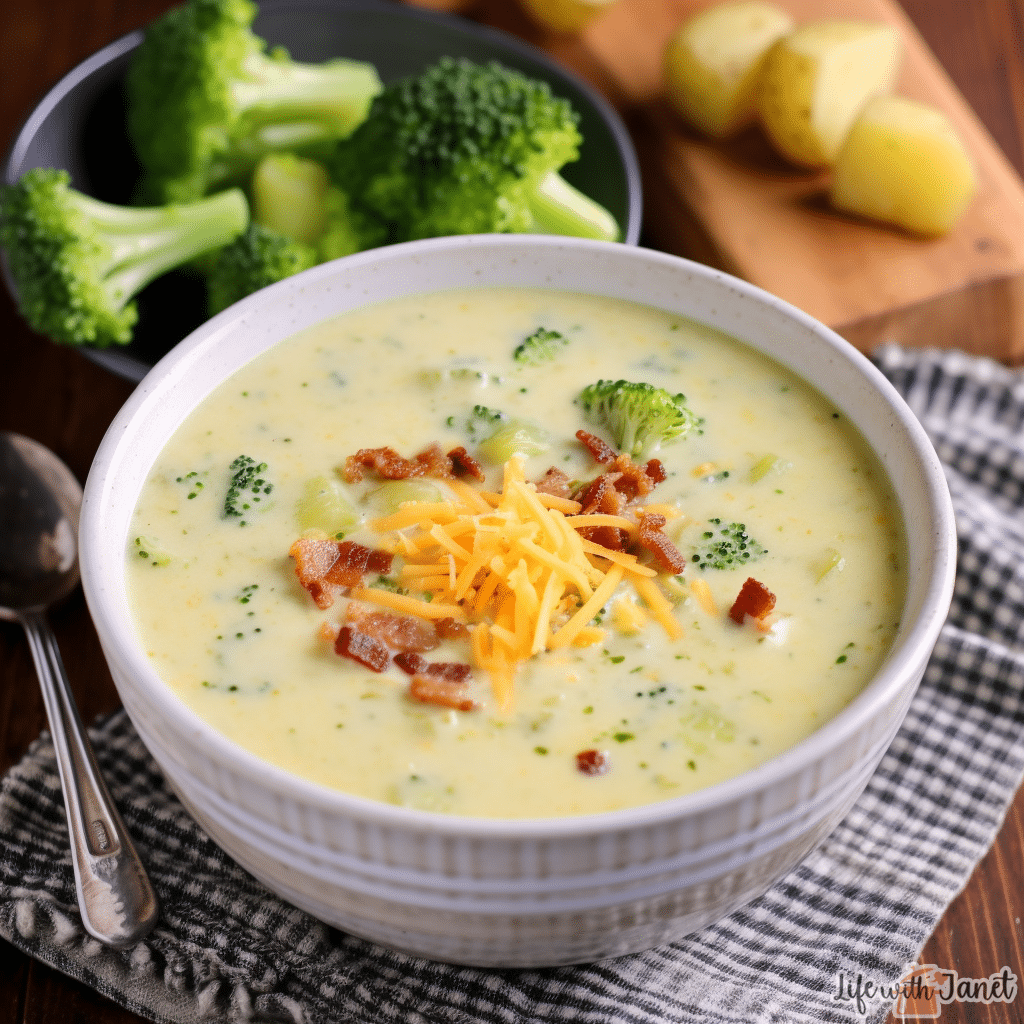
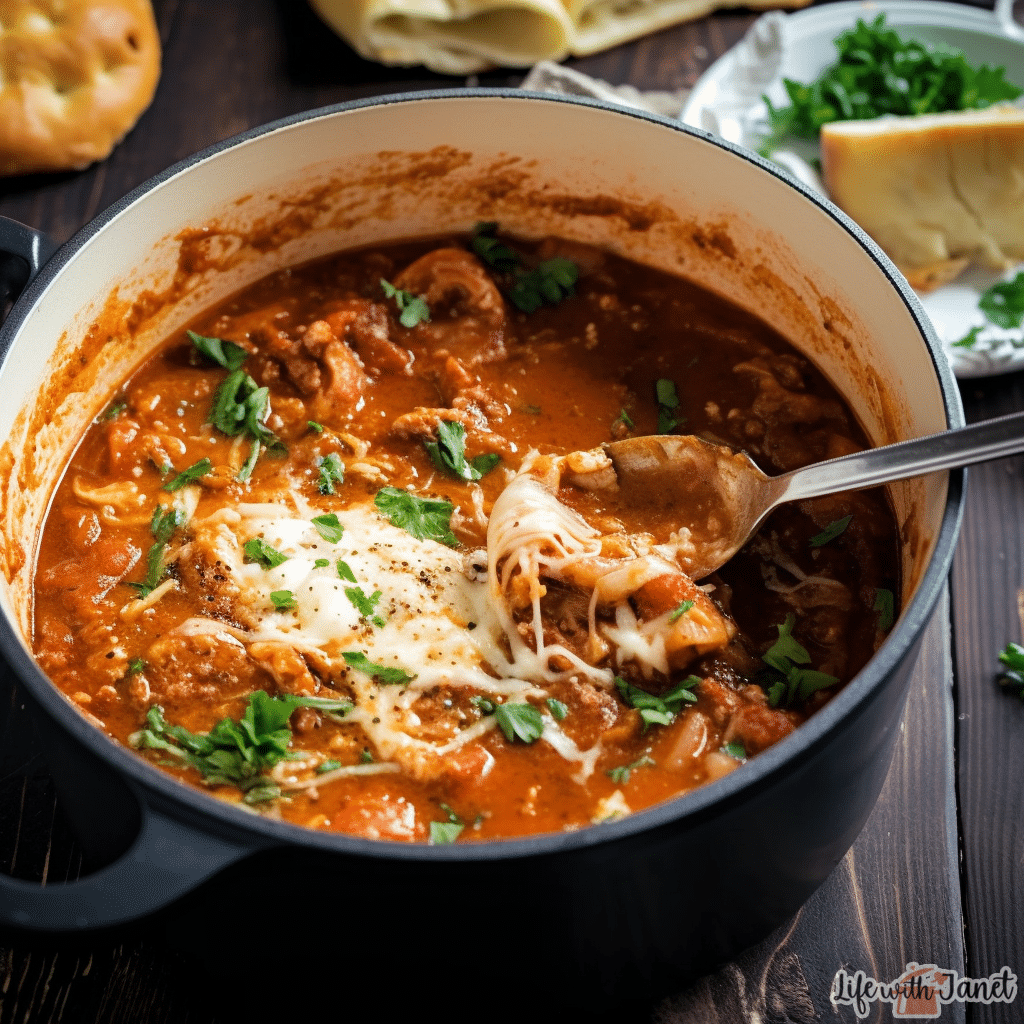
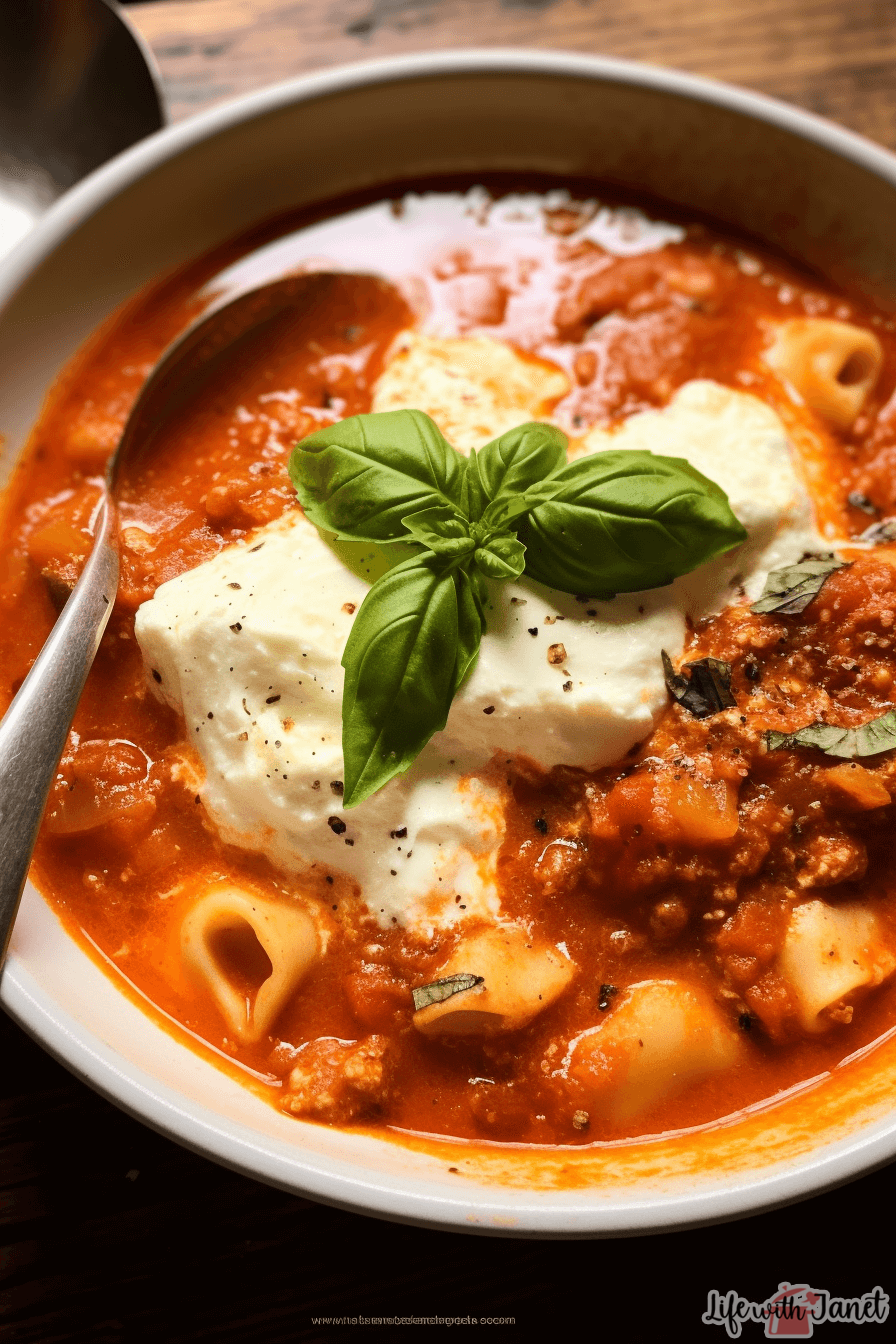
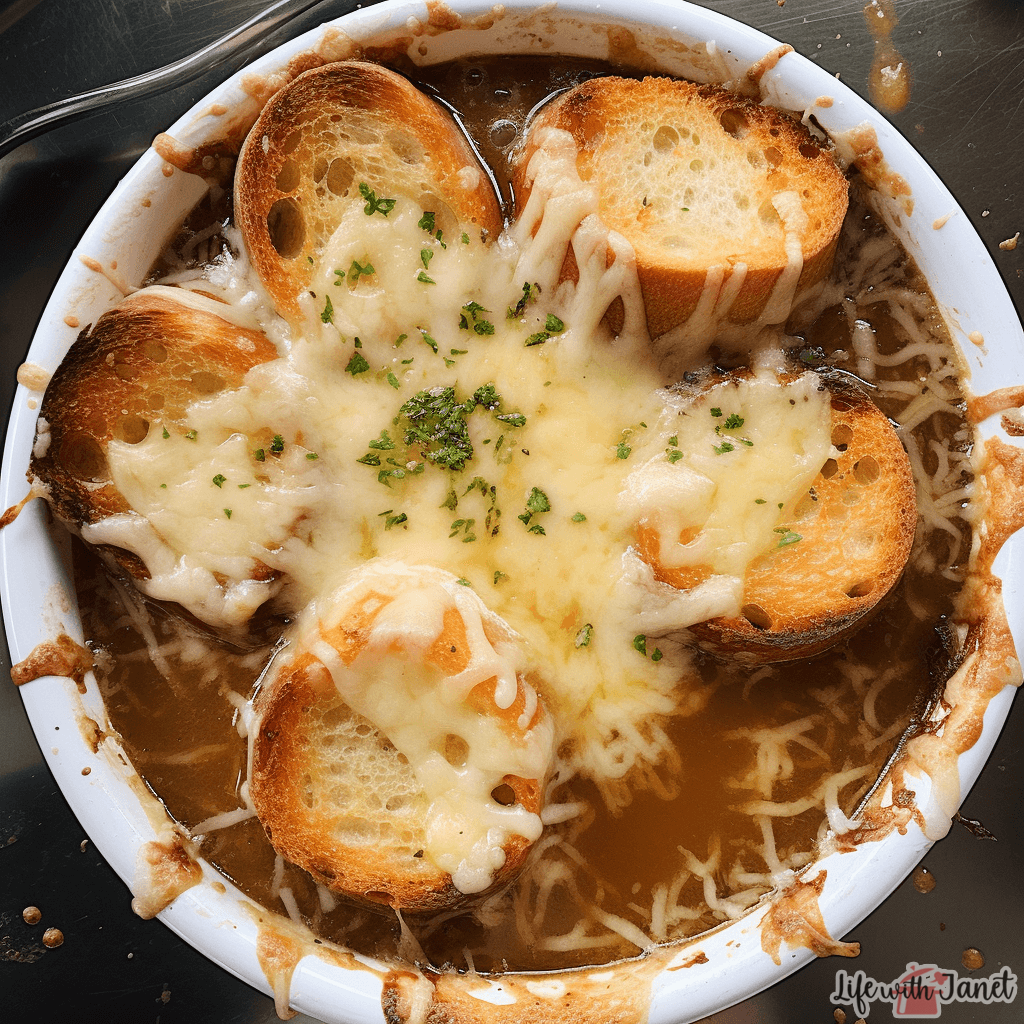
Your recipes are really great always won’t to try them thank you for them